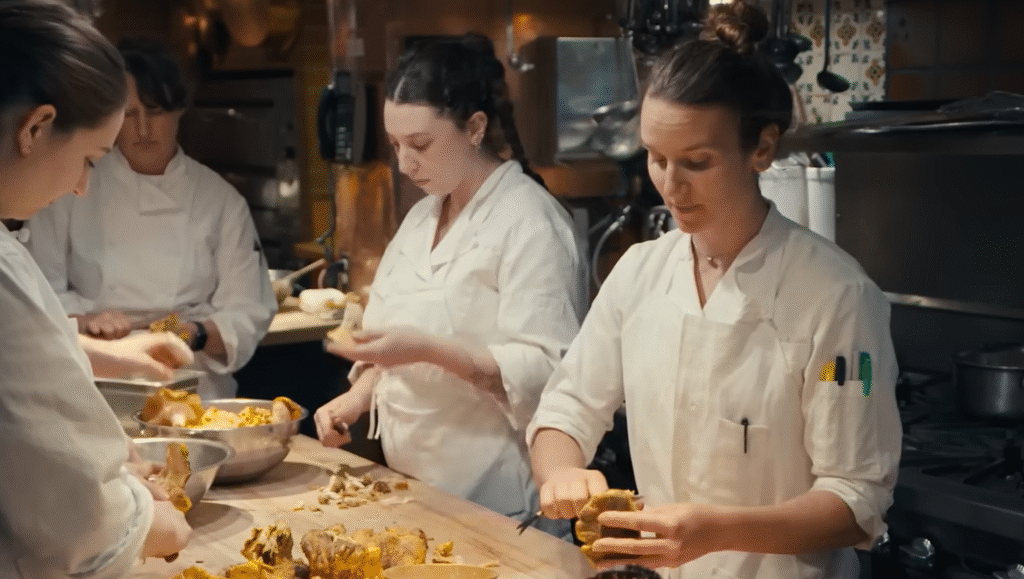Although Chez Panisse has long been hailed as a shining example of innovation, it is not only the cuisine but also the philosophy that makes it so timeless. Long before such concepts were popular, Alice Waters established her Berkeley institution as a culinary movement rather than just a restaurant by emphasizing organic, locally grown, and fresh ingredients. This decision had a profound impact on how Americans view food, influencing every subsequent farmers’ market movement and farm-to-table business.
Critics have argued in recent years whether Chez Panisse has become less influential in comparison to more recent establishments that embrace similar principles but execute them in a more ostentatious manner. However, this kind of criticism frequently undervalues its groundbreaking impact. In addition to praising flavor, Gourmet Magazine celebrated a revolution that had greatly shortened the gap between farm and plate when it named it the best restaurant in America in 2001. In contrast to fads, Chez Panisse’s philosophy has stood the test of time, remaining relevant for more than 50 years.
The restaurant’s reach is further demonstrated by its alumni network. Examples of how its kitchen became a training ground for concepts that reshaped modern cooking include Jeremiah Tower, one of the pioneers of California cuisine, and Samin Nosrat, who transformed Chez Panisse’s teachings into her best-selling book Salt, Fat, Acid, Heat. The way Harvard or Juilliard graduates rule their fields is remarkably similar to this; the name itself carries cultural weight that denotes authority.
Chez Panisse – Key Information
| Category | Details |
|---|---|
| Name | Chez Panisse |
| Founded | 1971 |
| Founder/Owner | Alice Waters |
| Location | 1517 Shattuck Avenue, Berkeley, California, USA |
| Cuisine | California cuisine, Farm-to-table, French-inspired |
| Signature Approach | Seasonal menus, local and organic ingredients |
| Restaurant Setup | Downstairs: fixed daily menu; Upstairs Café: à la carte menu |
| Notable Alumni | Jeremiah Tower, Samin Nosrat, Dan Barber, Suzanne Goin, April Bloomfield |
| Awards & Recognition | Gourmet Magazine “Best Restaurant in America” (2001); Top 50 Restaurants (2002–2008); Michelin star (2006–2009) |
| Cultural Role | Pioneer of sustainable dining, advocate for organic food movement |
| Official Website | chezpanisse.com |

Waters bypassed industrial systems and elevated sustainability into everyday practice by working with local farmers to create a direct pipeline of high-quality ingredients. In the 1970s, when processed convenience foods were the norm, this strategy was especially novel. Her model’s popularity has exploded in the last ten years, inspiring a new generation of chefs like Blue Hill’s Dan Barber, who also emphasizes the connection between soil health and flavor.
No legacy is without its difficulties, of course. Its 2010 Michelin star loss sparked discussions about whether simplicity can match the intricacy that contemporary fine dining frequently requires. However, Alice Waters has maintained that the objective was always to create honest food that respects producers and supports communities, not to gain recognition from guidebooks. In this regard, Chez Panisse has continued to be a very dependable representation of constancy. Diners are aware that the essence is memorable even if the presentation is simple.
Dining tables are only one aspect of Chez Panisse’s cultural significance. The connection between food and public policy was solidified when Michelle Obama asked Alice Waters to contribute her knowledge when she started the White House garden project. The fact that well-known chefs like Jamie Oliver and Yotam Ottolenghi have also cited Waters as an inspiration highlights how a single Berkeley restaurant subtly changed how society views issues like health, education, and even climate change. Waters also started the Edible Schoolyard project through strategic partnerships with nearby schools, proving that educating kids about seasonal produce can be a very effective way to create healthier futures.
Another aspect of Chez Panisse’s timeless appeal is its capacity to change without losing its essence. Following fires in 1982 and 2013, the eatery was restored, made significant improvements, and continued to operate. This tenacity is especially helpful in reaffirming its status as an institution founded on tenacity rather than just a place to eat.
Diners describe the experience as being similar to entering a storybook. The set menu in the dining room downstairs is updated every day, incorporating seasonal availability into a carefully planned story. For those who desire both spontaneity and sophistication, the à la carte freedom offered by the upstairs café is incredibly versatile. In an era of digital brevity, patrons frequently remark that the atmosphere is remarkably clear in its vision: not grandiose, but deeply intentional, akin to a handwritten letter.
The way that Chez Panisse’s influence converges with the contemporary celebrity-driven dining culture is what makes it particularly distinctive today. Even though René Redzepi and Gordon Ramsay receive most of the media attention, Alice Waters’s subdued activism continues to influence systemic change. Her work continues to be particularly innovative in the context of sustainability because she demonstrated how establishing connections with farmers could produce a model that is copied worldwide.
The ripple effect continues to affect society as a whole. The DNA of Chez Panisse is woven throughout projects that prioritize authenticity over performance, from urban community gardens in Los Angeles to zero-waste eateries in Copenhagen. By incorporating these principles into popular culture, Waters made sure that Chez Panisse was more than just a restaurant—rather, it was a movement that reinterpreted eating as a means of civic participation.

